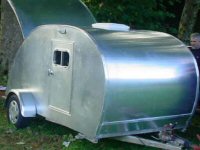mold/rot fighting strategies? Anyone tried this?
34 posts
• Page 1 of 3 • 1, 2, 3
mold/rot fighting strategies? Anyone tried this?
One school of thought here is to prevent condensation and/or leaking, use sprayed in foam. It's out of my budget so it's out. How about creating a system of insulation that instead allows easy access to the insulation panels and other rot/mold prone areas? Make the walls and ceilings semi modular? For example use clamp in wall treatments or threaded screw holes, or whatever, don't glue anything, make a wall, ceiling, appliance, foam panel easily replaceable. Moldy area? pop it out, pop in a new one. This won't work well for those that build beautiful built in cabinets with sophisticated electronics. But for us spartans, Run conduit on the outside of the walls (the post industrial look as I call it). Make everything easy to get to. I look at these diy videos of guys cutting holes for roof vents and stuff, they don't inspire confidence really. Water finds a way in. Granted, you'll never have the killer trailer, but for sure practicality perhaps there's value? Thoughts?
Related note, I've used sharkbyte connectors for various plumbing projects with good to great results. Anyone used them in CT? It goes with the modular theme again.
Related note, I've used sharkbyte connectors for various plumbing projects with good to great results. Anyone used them in CT? It goes with the modular theme again.
- sbshaver
- Teardrop Advisor
- Posts: 58
- Joined: Sat Aug 30, 2014 4:59 am
Re: mold/rot fighting strategies? Anyone tried this?
I just used shark connections for the first time on a water softener install and was surprised how easy they worked. At $20 for the fitting, it was expensive but it sure made the in-wall connection to copper easy and no soldering. I have pex equipment and the fittings are cheap.
The reality is that nothing is going to prevent water infiltration. CTT offer some of the best platforms because the structure doesn't have a lot of wood. Once rot and mold get started it's tough to stop. My plan is to minimize the amount of food. Steel frames, aluminum sidings, poly insulation, and similar products greatly reduce the chance of serious problems over the long haul.
Our last camper literally rotted from the inside, and we live in a dry climate. From the outside it looked fine. RV's twist and flex and bounce, making tight joints almost impossible, even with annual maintenance.
If I could afford it I would build an all aluminum trailer and use composite panels inside with spray foam in the walls. It would still leak.
The reality is that nothing is going to prevent water infiltration. CTT offer some of the best platforms because the structure doesn't have a lot of wood. Once rot and mold get started it's tough to stop. My plan is to minimize the amount of food. Steel frames, aluminum sidings, poly insulation, and similar products greatly reduce the chance of serious problems over the long haul.
Our last camper literally rotted from the inside, and we live in a dry climate. From the outside it looked fine. RV's twist and flex and bounce, making tight joints almost impossible, even with annual maintenance.
If I could afford it I would build an all aluminum trailer and use composite panels inside with spray foam in the walls. It would still leak.
- abqlloyd
- Teardrop Master
- Posts: 273
- Images: 3
- Joined: Mon Aug 08, 2005 11:47 pm



